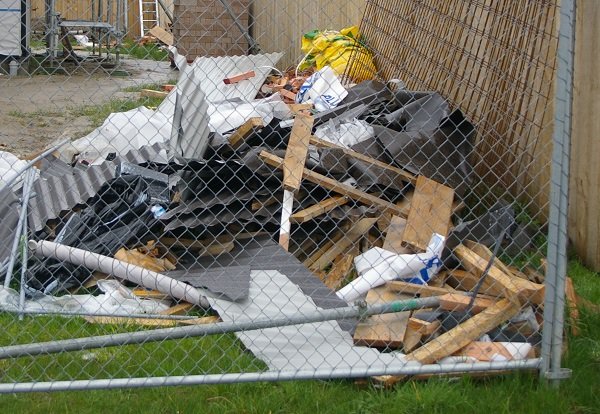The waste management plan should cover these things:
- Specify who is responsible for managing waste on site.
- Establish goals and objectives.
- Estimate the waste types and amounts involved.
- Set targets for reducing the amount of each waste sent to landfill.
- Describe recycling/reuse methods for each material.
- Identify the waste destinations and transport modes, including what materials are being segregated on site for reuse or recycling.
- Track progress.
- Describe special measures for material use and handling.
- Describe communication and training to support and encourage participation from everyone on site.
- If applicable, describe the sequencing and methods for deconstruction projects.
- Project review.
The waste management plan for each project will usually be the responsibility of the main contractor, and from this plan, specifications can be developed for bid/contractor packages outlining procedures for salvage, reuse and recycling. It can also be used to provide clients with details of actual reuse/recycling and disposal of waste.
In most cases, subcontractors would operate to the main contractor's plan. Where subcontractors have sole responsibility for their waste, they should complete their own waste management plan.
A new plan needs to be prepared for each job/site.

Completing a waste management plan
Enter details on a copy of the REBRI waste management plan [WORD, 115KB] .
Assign responsibility
Designate one person to be responsible for managing waste on site. This will ensure that a waste management plan is followed. Whoever is in charge of waste minimisation needs to be enthusiastic about championing the project - reducing construction site waste is a team effort - and it's important that the individuals responsible know who they are!
Establish goals and objectives
Set broad goals and objectives related to the following:
- Eliminate the generation of waste, as a priority.
- Recycle and reuse waste that is created on the job.
- Use construction methods that allow for deconstruction.
- Use products and materials that reduce waste.
Estimate waste amounts
Forecast the types and percentages of waste that will be produced. Start off with your usual waste percentages - if you have no basis for comparison, use the New Zealand construction industry averages given below.
| Material | Estimated waste percentages |
|---|---|
| Fibre-cement board | 7% |
| Timber | 11% |
| Plasterboard | 13% |
| Particleboard | 9% |
| Concrete | 5% |
| Fixings | 4% |
| Roofing | 6% |
Set targets for reduction
Use the REBRI resource routing calculator to determine what materials will be recycled. Set a target for each waste type, for example, reduce waste by 20% by the project's end.
Describe recycling/reuse methods
- Identify the possibilities for reuse and recycling for each type of waste that is created and describe these - where, how and when to handle waste materials.
- Attach a site plan with key areas marked if possible.
Identify waste destinations
- Find out the available local recycled/recovered materials outlets and what opportunities there are for collection.
- Keep a current list of recycling operators in the site office for easy reference.
- List the specific recycling operator's details for each material.
Track progress
- Keep records of waste recycled/reused, waste removed and the related costs/savings.
- Use the REBRI waste transfer form [WORD, 36KB] to record details of waste sent off site.
Here's an example of a completed waste minimisation record, using the REBRI resource routing calculator to determine the most economic destination of waste:
| MATERIAL | Normal % sent to landfill | Target % sent to landfill | On-site recycling method or reuse | Waste destination - contacts and information | Actual quantity recycled, reused etc. | Actual % sent to landfill | Actual cost or saving |
|---|---|---|---|---|---|---|---|
| Concrete | 5 | 2 | Hardfill, temporary paths, drainage | Concrete recycler - see Yellow Pages | 140 kg | 3% | $250 |
| TOTAL |
Material use and handling
Use this section to identify any recycled and second-hand materials or materials with recycled content being used on the project.
Also identify any special handling or storage measures to protect reusable and recyclable materials from damage and to ensure materials are consistent with requirements for acceptance by designated facilities
Communication and training
Explain what will be done to educate and inform all construction workers and subcontractors about the waste minimisation goals and techniques for the project and the waste management system that has been established and attach any relevant documentation.
Encourage participation. Put the waste minimisation record up on the site noticeboard and update it regularly to let everyone know about progress, and set up an ideas board for waste-related suggestions.
Sequencing and methods for deconstruction projects
For a deconstruction project, describe the deconstruction sequencing and methodology to be followed and attach any relevant documentation.
Describe any special materials handling and removal procedures, particularly on project sites with space constraints.
Project review
At the end of the project, add your ideas about strengths, weaknesses and suggested actions. See Reviewing the process for more information.